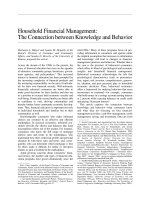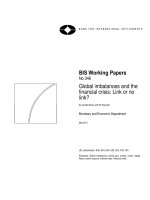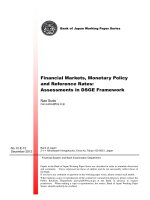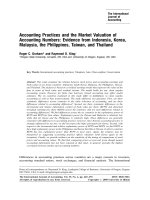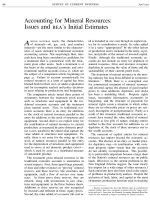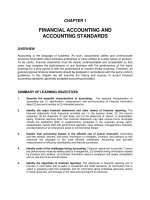Critical Financial Accounting Problems Issues and Solutions_6 doc
Bạn đang xem bản rút gọn của tài liệu. Xem và tải ngay bản đầy đủ của tài liệu tại đây (174.11 KB, 20 trang )
126 Critical Financial Accounting Problems
Exhibit 6.5
Alvertos Company: Lease Amortization Schedule (Lessee’s Computation);
Annuity Due Basis and Guaranteed Residual Value (GRV)
*rounded
(a) Required lease payments
(b) Executory costs paid by the lessee and included in rental payments
(c) Column (e) at the preceding balance ϫ 10% except for 1/1/96
(d) (a) Ϫ (b) Ϫ (c)
(e) Preceding balance Ϫ (d)
3. Present value of minimum lease payments
$50,000.00
The Alvertos Company lease amortization schedule is shown in Exhibit
6.5. It is the basis for the following entries:
1. Capitalization of lease on January 1, 1996.
Leased Equipment under Capital
Leases $50,000
Obligation under Capital
Leases $50,000
2. First rental payment on January 1, 1996
Property Tax Expense $3,000.00
Obligations under Capital Leases $11,618.543
Cash $14,618.543
Accounting for Leases 127
3. Recognition of accrued interest on December 31, 1996
Interest Expense $3,838.145
Interest Payable $3,838.145
(or Accrued Interest
Obligation under Capital
Leases)
4. Recognition of the annual depreciation of leased equipment on December 31,
1996.
Depreciation Expense-Capital
Leases $9,500.00
Accumulated Deprecation–
Capital Leases $9,500.00
[($50,000 Ϫ $2,500) /5 years]
5. At the end of the year 1996, the Obligation Under Capital Leases in the
balance sheet is divided into its current and noncurrent portions as follows:
A. Current Liabilities
Interest Payable $3,838.145
Obligations under Capital Leases $7,780.398
B. Noncurrent Liabilities
Obligations under Lease $30,601.059
6. Recording the second rental payments in advance January 1, 1997
Property Tax Expense $3,00.00
Obligations under Capital Leases $7,780.398
Accrued Interest on Obligations
under Capital Leases $3,838.398
Cash $14,618.543
7. The same patterns of entries are followed through the year zero
The Case of an Unguaranteed Residual Value
The lessee does not recognize the unguaranteed residual value in the
computation of the minimum lease payments and the capitalization of
the leased asset under obligation. To illustrate, let’s return to the Zribi
Company as the lessor and the Alvertos Company as the lessee example
and assume that the Alvertos Company does not agree to guarantee the
entire amount of the residual value of $2,500. The capitalized amount
for the Alvertos Company is as follows:
1. Present value of five annual rental payments discounted at 10%
128 Critical Financial Accounting Problems
Exhibit 6.6
Alvertos Company: Lease Amortization Schedule (Lessee’s Computation);
Annuity Due Basis and Unguaranteed Residual Value
*Rounding error
($11,681.543 ϫ 4.16986) $48,447.70
Plus
2. Unguaranteed residual value of $2,500 not capitalized
$——-0——-
3. Present value of minimum lease payments
$48,447.70
The Alvertos Company lease amortization schedule is shown in Exhibit
6.6. It is the basis for the following entries:
1. Capitalization of lease on January 1, 1996
Leased Equipment under Capital
Leases $48,447.70
Obligation under Capital
Leases $48,447.70
2. First rental payment on January 1, 1996
Property Tax Expense $3,000.00
Obligations under Capital Leases $11,618.543
Cash $14,618.543
3. Recognition of accrued interest on December 31, 1996
Interest Expense $3,682.915
Accounting for Leases 129
Interest Payable $3,682.915
4. Recognition of annual depreciation expense on December 31, 1996
Depreciation Expense–Capital
Leases $9,689.54
Accumulated Depreciation–
Capital Leases $9,689.54
($48,447.70/5 years)
5. At the end of the year 1996 the Obligation under Capital Leases in the
balance sheet is divided into its current and noncurrent portions as follows:
A. Current Liabilities
Interest Payable $3,682.915
Obligations under Capital
Leases $7,935.628
B. Noncurrent Liabilities
Obligation under Capital
Leases $28,893.529
6. Recording the second rental payment on January 1, 1997
Property Tax Expense $3,000.00
Obligations under Capital
Leases $3,682.915
Accrued Interest on
Obligations under
Capital Leases $7,935.628
Cash $14,618.543
7. The same patterns of entries are followed through the year zero.
The Case of a Residual Value for the Lessor
For the lessor the assumption is that the residual value will be realized
whether it is guaranteed or unguaranteed. Returning to the previous ex-
ample of the Zribi Company as the lessor and the Alvertos Company as
the lessee and the residual value of $2,500 (whether guaranteed or un-
guaranteed), the following information is relevant to the lessor:
1. Gross Investment: ($11,618.543 ϫ 5) ϩ $2,500 ϭ $60,592.715
2. Unearned interest revenue:
$60,592.715 Ϫ $50,000 ϭ $10,592.715
3. Net Investment ϭ $60,592.715 Ϫ $10,592.715 ϭ $50,000.00
130 Critical Financial Accounting Problems
Exhibit 6.7
Zribi Company: Lease Amortization Schedule (Lessor’s Computation);
Annuity Due Basis and Guaranteed Residual Value (GRV)
*rounded
(a) required lease payments
(b) Executory costs paid by the lessee and included in rental payments
(c) Column (e) at the preceding balance ϫ 10% except for 1/1/96
(d) (a) Ϫ (b) Ϫ (c)
(e) Preceding balance Ϫ (d)
The lease amortization schedule for the lessor is illustrated in Exhibit 6.7. It is
the basis of the following entries:
1. Initial recording of the lease at its inception on January 1, 1996
Lease Payments Receivable $60,592.715
Equipment $50,000.00
Unearned Interest Revenue–
Leases $10,592.715
2. Recording of first rental payment on January 1, 1996
Cash $14,618.543
Lease Payments Receivable $11,618.543
Property Tax Expense/
Property Tax Payable $3,000.00
3. Recognition of accrued interest on December 31, 1996
Unearned Interest Revenue-
Leases $3,838.145
Interest Revenue-Leases $3,838.145
Accounting for Leases 131
SALES-TYPE LEASES: ACCOUNTING FOR THE
LESSOR
The major difference between a direct financing lease and a sales type
lease is the presence of a manufacturer’s or dealer’s profit or loss in a
sales-type lease and the accounting for initial direct costs. This profit or
loss is equal to the difference between:
1. The present value of the minimum lease payments (net of executory costs)
computed at the interest rate implicit in the lease (i.e., the sales price), and
2. The cost or carrying value of the asset plus any initial direct costs less the
present value of the unguaranteed residual value accruing to the benefit of
the lessor.
To illustrate a sales-type lease, let’s assume the same example as in direct
financing where (a) the residual value is $2,500 (with a present value of
$1,553.30), (b) the equipment had a cost of $40,000 to the lessor, the
Zribi Company and (c) the fair market value of the residual value is
$1,000.
A. The following information is relevant to the lessee in case the residual value
is a guaranteed residual value:
1. Gross Investment: ($11,618.543 ϫ 5) ϩ $2,500 ϭ $60,592.715
2. Unearned Interest Revenue: $60,592.715 Ϫ $50,000 ϭ $10,592.715
3. Sale Price of the Asset: ($48,447.70 ϩ $1,552.30) ϭ $50,000.00
4. Cost of Goods Sold: $40,000
5. Gross Profit: ($50,000 Ϫ $40,000) ϭ $10,000
B. The following information is relevant to the lessor in case of an unguaranteed
residual value:
1. Gross Investment: ($11,618.543 ϫ 5) ϩ $2,500 ϭ $60,592.715
2 Unearned Interest Revenue: $60,592.715 Ϫ $50,000 ϭ $10,592.715
3. Sale Price of the Asset: $48,447.70
4. Cost of Goods Sold: $40,000 Ϫ $1,552.30 ϭ $38,447.70
5. Gross Profit: ($48,447.70 Ϫ $38,447.70) ϭ $10,000.00
C. The entries assuming guaranteed residual value are:
1. Initial recording of the sales-
type lease on January 1, 1996
Minimum Lease Receivable $60,592.715
Cost of Goods Sold $40,000.00
Sales Revenue $50,000.00
Equipment Held for Lease $40,000.00
Unearned Interest Leases $10,592.715
132 Critical Financial Accounting Problems
2. Collection of annual payment on January 1, 1996
Cash $14,618.543
Minimum Lease Receivable $11,618.543
Property Expense/Payable $3,000.00
3. Recognition of interest revenue on December 31, 1996
Unearned Interest-Leases $3,682.915
Interest Revenue $3,682.915
4. Collection of second annual payment for January 1, 1997
Cash $14,618.543
Minimum Lease Receivable $11,618.543
Property Expenses/Payable $3,000.00
5. Recognition of interest revenue as of December 31, 1997
Unearned Interest-Leases $2,889.352
Interest Revenue $2,889.352
6. Recognition of residual value at the end of lease term (December 31,
2000)
Equipment $1,000.00
Cash $1,500.00
Lease Payment Receivable $2,500.00
D. The entries assuming an
unguaranteed residual value are:
1. Initial recording of the sales-type lease on January 1, 1996
Minimum Lease Receivable $60,592.715
Cost of Goods Sold $38,447.70
Sales Revenue $48,447.70
Equipment $40,000.00
Unearned Interest Revenue $10,592.715
2. Collection of annual payment for January 1, 1996
Cash $14,618.543
Minimum Lease Receivable $11,618.543
Property Tax Expense/
Payable $3,000.000
3. Recognition of interest revenue on December 31, 1996
Unearned Interest-Leases $3,682.915
Interest Revenue $3,682.915
4. Collection of second annual payment for January 1, 1997
Cash $14,618.543
Minimum Lease Receivable $11,618.543
Property Tax Expense/
Payable $3,000.000
Accounting for Leases 133
5. Recognition of interest revenue on December 31, 1997
Unearned Interest-Leases $2,889.352
Interest Revenue $2,889.352
6. Recognition of residual value at the end of the lease term (December
31, 2000)
Equipment $1,000.00
Cash $1,500.00
Lease Payment Receivable $2,500.00
ACCOUNTING FOR INITIAL DIRECT COSTS BY THE
LESSOR
Initial direct costs have been redefined in FASB Statement No. 91.
11
Basically, the initial direct costs of a lease transaction include two types,
as follows: (1) Incremental direct costs as the costs resulting from the
lease and are essential to the lease transaction; (2) Internal direct costs
are the costs related to the evaluation of the lessee’s personal condition,
and other costs of the activities performed by the lessor.
The accounting treatment for initial direct costs is different for each
type of lease:
1. For an operating lease, the initial direct costs are recorded as prepaid assets
and allocated over the lease term as an expense proportionally to the rental
receipts.
2. For a direct financing lease, the initial direct costs are deferred and added to
the net investment in the leases and amortized over the life of the lease as a
yield adjustment.
3. For a sales-type lease, the initial direct costs are expensed in the same period.
ACCOUNTING FOR SALE-LEASEBACK
A sale-leaseback occurs when the owner of the asset sells the asset to
another and simultaneously leases it back from the buyer to (a) benefit
from better financing and (b) derive a tax advantage from deducting the
entire lease payment. Two situations are possible:
1. If the lease meets the condition for a capital lease, the profit from the trans-
action is deferred and amortized over the lease term by the lessee in pro-
portion to the amortization of the leased asset.
2. If the lease does not meet the conditions for a capital lease, it is considered
an operating lease and the profit is amortized proportionally to the rental
payments.
134 Critical Financial Accounting Problems
Any loss, however, is recognized immediately. To illustrate a sale-
leaseback transaction, assume that the Lessee Corporation, on January 1,
1996, sells a ship having a book value of $2,460,000 to the Lessor Cor-
poration for $10,460,000 and simultaneously leases it back under the
following conditions:
1. The term of the lease is four years, noncancellable.
2. The payments at the beginning of every year are of $3,000,000.
3. The fair value of the ship is $10,460,000 on January 1, 1996, with a four-
year economic life.
4. The lessor’s rate is 10%.
Assuming the lease is a capital lease, the entries based on Exhibit 6.8
are as follows:
1. Sale of ship by the lessee to the lessor on January 1, 1996
Cash $10,460,000
Ship $2,460,000
Unearned Profit on Sale-
Leaseback $8,000,000
2. Initial recording of sale-leaseback on January 1, 1996
Leased Ship under Capital Leases $10,460,000
Obligations under Capital
Leases $10,460,000
3. Recording of first lease payment on January 1, 1996
Obligations under Capital Leases $3,000,000
Cash $3,000,000
4. Recording of depreciation expense on December 31, 1996
Depreciation Expense $2,615,000
Accumulated Depreciation
($10,460,000/4) $2,615,000
5. Amortization of unearned profit on sale-leaseback on December 31, 1996
Unearned Profit on Sale-
Leaseback $2,000,000
Realized Profit on Sale-
Leaseback
(or Depreciation Expense-
Leased Ships)
($8,000,000/4) $2,000,000
Accounting for Leases 135
Exhibit 6.8
Lessee’s Lease Amortization Schedule
6. Recognition of interest expense on December 31, 1996
Interest Expense $746,000
Interest Payable $746,000
To the lessor the entries are as follows on January 1, 1996
1. Ship $10,460,000
Cash $10,460,000
2. Lease payments Receivable ($3,000,000 ϫ 4) $12,000,000
Ship $10,000,000
Unearned Interest Revenue $2,000,000
3. Cash $3,000,000
Lease Payments Receivable $3,000,000
ACCOUNTING FOR LEASES INVOLVING REAL
ESTATE
There are specific issues for accounting for leases involving real estate
that include lease of land only, lease of both land and building and lease
of real estate and equipment.
A. If the lease involves land only, the lease for the lessee is a capital
lease if (a) there is a transfer of ownership and (b) there is a bargain
purchase option; otherwise it is an operating lease. For the lessor the
lease is either a sale-type or a direct financing lease if it meets the own-
ership conditions, the bargain purchase option condition and the collec-
tibility and uncertainty tests. Otherwise it is an operating lease.
136 Critical Financial Accounting Problems
B. If the lease involves both land and building and meets the owner-
ship conditions and the bargain purchase option conditions, it is a capital
lease for the lessee and either a sale-type lease or a direct financing lease
for the lessor depending on the existence of a profit or loss.
C. If the lease involves both land and building, does not meet the
ownership conditions and the bargain purchase option conditions, and
the fair value of the land and buildings is less than 25% of the fair value
of both the land and buildings, the land portion is ignored and the lease
is classified on the basis of the building characteristics.
D. If the lease involves both land and building, does not meet the
ownership condition and the bargain purchase option condition, and the
fair value of the land is more than 95% of the fair value of both land
and buildings, both the lessee and the lessor account for the land as an
operating lease and the building as a capital lease if it meets the neces-
sary requirements.
E. If the lease involves both real estate and equipment, the portion of
the minimum lease payments applicable to the equipment portion of the
lease should be estimated by whatever means are appropriate. The clas-
sification of the equipment is done separately from the real estate. The
accounting for the real estate portion proceeds as described in the pre-
ceding section. For a leased property which is part of a large building,
‘‘reasonable estimates of the lease property’s fair value might be objec-
tively determined by referring to an independent appraisal of the lease
property or to estimated replacement cost information.’’
12
NOTES
1. ‘‘Accounting for Leases,’’ FASB Statement No. 13 as Amended and In-
terpreted through January 1990 (Norwalk, Conn.: FASB, 1990), Sec. 1.10.101.
2. John H., Myers, ‘‘Reporting of Leases in Financial Statements,’’ Ac-
counting Research Standard No. 4 (New York: AICPA, 1964).
3. Yuji Ijiri, Recognition of Contractual Rights and Obligations, Research
Report (Stamford, Conn.: FASB, 1980).
4. Donald E. Kieso and Jerry J. Weygandt, Intermediate Accounting, 4th
ed. (New York: John Wiley & Sons, 1993), p. 1123.
5. E. A. Imhoff, Jr., R. C. Lipe, and D. W. Wright, ‘‘Operating Leases: Im-
pact of Constructive Capitalization,’’ Accounting Horizons (March 1991).
6. ‘‘Accounting for Leases,’’ par. 7.
7. Ibid.
8. ‘‘Accounting for Leases,’’ par. 5(1).
9. Ibid., par. 5(k).
Accounting for Leases 137
10. Kieso and Weygandt, Intermediate Accounting, p. 1133.
11. ‘‘Accounting for Nonrefundable Fees and Costs Associated with Origi-
nating or Acquiring Loans and Initial Direct Costs of Leases,’’ FASB Statement
of Financial Accounting Standards No. 91 (Stamford, Conn.: FASB, 1987).
12. ‘‘Leases Involving Only Part of a Building,’’ FASB Interpretation No.
24 (Stamford, Conn.: FASB, 1978), par. 6.
7
Segmental Reporting
The growth of conglomerate multinational corporations, international ac-
counting and/or international trade has led to a need for segmental re-
porting. Rather than being limited to a reporting of financial position,
performance and conduct of the whole firm, segmental reporting would
add specific reporting of the activities of identifiable and reportable seg-
ments of the firm. There was, in addition, an international call for such
reporting as firms expanded beyond their domestic activities to generate
revenues and perform operations outside the borders of their parents’
countries. Therefore, diversification, added to the internationalization of
the firms, presented an opportunity for change in the framework of ac-
countability and disclosure toward a combination of aggregate and less
aggregate forms of reporting. Like all reporting issues, segmental re-
porting generated a debate about its implementation, the nature of ac-
counting standards, its impact on users in the market and its potential
predictive ability. This chapter elaborates on the various aspects of this
debate and its international and managerial ramifications.
NATURE OF SEGMENTAL REPORTING
Firms have been reacting to their environments by adopting new or-
ganizational structures based on decentralization and the development or
acquisition of domestic or foreign segments. What results is a more di-
versified company. Robert K. Mautz offers the following definition of a
diversified company:
140 Critical Financial Accounting Problems
A company which is either so managerially decentralized, so lacks operational
integration, or has such diversified markets that it may experience rates of prof-
itability, degrees of risk, and opportunities for growth which vary within the
company to such extent that an investor requires information about these vari-
ations in order to make informed decisions.
1
What appears from this definition is that first the phenomenon of diver-
sification emanates from management decentralization, a lack of opera-
tional integration, or activity in diverse markets; and second that the
differences in the financial profits of the segments call for segmental
reporting deemed useful to investors.
Segmental reporting consists, therefore, in providing relevant infor-
mation about segments. It can be rationalized within the ‘‘Fineness The-
orem’’ of the information economics literature.
2
It implies that the
information system
n1
is said to be ‘‘as fine as’’ the information system
n0
if
n1
is a ‘‘subpartition’’ of
n0
; that is, if each data set of
n1
provides a
partitioning of the states of nature which is at least as detailed (or as
‘‘fine’’) as that present in the data sets of
n0
. Applied to segmental re-
porting, it implies that the information system obtained by segmental
reporting and consolidated data together is ‘‘finer’’ than the disclosure
of consolidated data alone. The fineness argument does not, however,
consider the incremental costs required by the additional disclosure. Ro-
seanne M. Mohr elaborates as follows:
It must be noted, however, that the costs of the ‘‘finer’’ disclosures could impair
the theoretical result. Although the gathering and reporting costs associated with
segmental disclosure may be small (due to the use of similiar data in managerial
decision contexts), externalities and practical data limitations would still impose
greater cost. For example, competitive reactions or managerial reluctance to
adopt ‘‘risky’’ projects may affect the expected payoff to the decision maker.
Furthermore, uncertainty about data reliability and comparability would inhibit
the use of the incremental disclosure of segment earnings data, wherein differ-
ences in cost determination methods and in common cost allocation schemes
can influence the reported amounts.
3
EVALUATION OF SEGMENTAL REPORTING
Use of Segmental Reporting
The use of segmental reporting had been on the increase even before
the international standard setters made some calls for it. Attitudinal stud-
Segmental Reporting 141
ies of preparers and users in the United States showed at the time an
expressed interest in the dissemination of segmental reporting. These
studies include one on financial analysts and commercial bankers by
Morton Backer and Walter B. McFarland,
4
and one on financial analysts
and corporate executives by Mautz.
5
Another attitudinal study by J. Cra-
mer reported some of the perceived problems of segmental reporting
experienced by corporate controllers, namely, in defining the segments,
the restrictions on data comparability that might result from the use of
different cost allocation and transfer pricing techniques; and finally, the
externality costs associated with the development of auditing standards,
the increased legal exposure of managers and auditors and the reaction
of competitors.
6
S. J. Gray and Lee H. Radebaugh examined the extent of geographical
information provided in practice in the United States and the United
Kingdom, and the significant differences in the nature and content of
disclosures between countries both in terms of voluntary disclosures and
those required by accounting standards.
7
Given the greater flexibility in
the applications of regulations governing segment disclosures in the
United States as well as reduced scope in terms of the amount of infor-
mation to be disclosed, it is not surprising that their findings indicate
that U.S. firms disclose more segment information, especially with re-
spect to intraenterprise sales, profits and assets. In the case of employees,
however, the increased emphasis on employee reporting in the United
Kingdom may explain the greater disclosure of employee information in
the United Kingdom. An interesting result was that U.S. firms disclosed
fewer geographic segments than did the U.K. firms, and a higher level
of aggregation. The following explanation was provided:
One final note relates to the demand of investors for information, U.K. segment
disclosure practices are determined by the London Stock Exchange and, therefor,
its investors. This has resulted in more segments than for U.S. firms, as sum-
marized above, but certainly not in more information per segment. Large MNE’s
(Multinational enterprises), such as those in this study, actively use the inter-
national markets to raise debt as well as equity capital, so they effectively com-
pete with each other for capital. In spite of this, the more extensive information
required of U.S. MNEs has not resulted in U.K. firms trying to match U.S. firms
in terms of disclosure. It is evident that the Capital market has not insisted on
this information from U.K. firms, leading one to question the necessity of the
fuller range of U.S. disclosure.
8
142 Critical Financial Accounting Problems
Gray also examined the European experience with segmental reporting
and found that U.K.–based companies exhibited greater disclosure of
business analyses of profits and geographical analyses of sales and prof-
its.
9
Factors explaining the differences included managerial (corporate
strategy, organizational structure and cost and competitive aspects), legal
and political, professional and stock market and investment environ-
ments. Two variables were singled out as more important: the structure
of the company with respect to the extent of its economic integration
and managerial coordination, and the differential stimulus to disclosure
provided by the regulatory environment of legal, professional and stock
market requirements. According to Gray:
the impact of the formal variable is difficult to assess from company reports,
and further research into the aspect would seem useful to determine the feasi-
bility of disclosure. With regards to the impact of the latter variable, there is
little doubt about the unsatisfactory nature of existing disclosure requirements,
such as they are. The critical problem is that of defining appropriate criteria for
the identification of reportable segments. This is a difficulty which is currently
thwarting the developement of segment reporting in the EEC, given that a case
for providing such information is perceived to exist by some of the rule-making
bodies concerned.
10
Evaluation of Segmental Reporting
Various arguments have been made with regard to segmental reporting
since business concerns began to grow and acquire a multisegmental
characteristic.
The usefulness of segmental reporting was linked generally to (a) the
informational content of the information in terms of the profitability, risk
and growth of the different segments of a firm, and (b) the relevance to
users in their assessment of the earnings potential and the risk of com-
pany as a whole, to governments in their developement of public policy
positions on multinational and/or large companies and to management
encouraging a corporate strategy. This last point is raised as follows:
Managerial efficiency may be promoted by the attention to corporate strategy
that the publication of segmented reporting will encourage. Management may
also be concerned to evaluate their internal management control system. The
provision of segmental reports will necessitate managerial evaluation of cost
allocation procedures and the bases on which transfer prices between segments
are calculated. Perhaps the most important spur to efficiency could be the in-
Segmental Reporting 143
creased competition that may result from segmental disclosures with consequent
benefits to the economy as a whole. The effect of this may be exaggerated,
however, as all companies will be similarily placed. But it may at least redress
to some extent the competitive disadvantage experienced by the unitary com-
pany, with no business or geographical diversification, as compared to the mul-
tibusiness-multinational company whose operations have become progressively
complex and whose financial statements have become correspondingly opaque.
11
Naturally, as in all accounting issues, not all arguments are in favor
of segmental reporting. Not only is the usefulness of segmental reporting
questioned when compared to the role of consolidated data, but also the
costs of disclosure are raised as a subject of concern. The question is
whether the cost of segmental disclosure could serve to offset the theo-
retical benefits of ‘‘finer’’ information systems. There is undoubtedly
limited evidence with regard to the cost aspects of segmental disclosure,
in addition to the lack of evidence on information-processing issues,
data-reliability considerations and externality costs. There is also the
problem of the lack of comparability when ‘‘(i) apparently similar seg-
ments in different firms may be identified differently, (ii) the treatment
of inter-segment transfers may differ, and (iii) common costs may be
allocated over different bases.
12
THE U.S. POSITION ON SEGMENTAL REPORTING
Official Pronouncements
The U.S. position on reporting financial information by segment is
mainly expressed in FASB Statement No. 14, Financial Reporting for
Segments of a Business Enterprise. Other applicable authoritative state-
ments include Statements 18, 21, 24, 30 and 69, and technical bulletins
79–4, 79–5 and 79–8. FASB Statement No. 14 requires public companies
whose securities are publicly traded or which are required to file financial
statements with SEC to include disaggregated information about opera-
tions in various industries, foreign operations, export sales and sales to
major companies. FASB Statement No. 221, Suspension of the Reporting
of Earnings Per Share and Segment Information by Nonpublic Enter-
prises, exempts nonpublic firms from the provisions of FASB Statement
No. 14. Similarily, FASB Statement No. 24, Reporting Segment Infor-
mation in Financial Statements That are Presented in Another Enter-
prise’s Financial Report, exempts the reporting entity whose consolidated
144 Critical Financial Accounting Problems
financial statements contain separable financial statements in the follow-
ing circumstances:
1. The separable financial statements are also consolidated or combined in a
complete set of financial statements and both sets of financial statements are
included in the same financial reports;
2. The separable financial statements are those of a foreign investee (not a
subsidiary) of the primary reporting unit, and the separable financial state-
ments do not follow the provisions of SFAS No. 14; or
3. The separable financial statements are those of an investee accounted for
using the cost or equity method.
Therefore, SFAS No. 21 and No. 24 affect the applicability of SFAS
No. 14, by putting forth limitations.
Because SFAS No. 14 differentiates between domestic and foreign
operations, the following presentation will make the same differentiation.
Domestic Operations
In SFAS No. 14 an industry segment is defined as a component of an
enterprise, engaged in providing a product or service, or a group of
related products and services, primarily to unaffiliated customers for a
profit. The first requirement of SFAS No. 14 is the determination of the
industry segments that need to be reported separately. The three-step
procedure goes as follows: First, the company should identify sources of
revenue (by product or service rendered) on a worldwide basis for entity;
second, the company should group related products and services into
industry segments. Three factors from paragraph 100 of SFAS No. 14
are to be considered in determining industry segment as follows:
1. The nature of a product. Related products have similiar purposes or end uses.
Thus, they may be expected to have similar rates of profitability, similiar
degrees of risk, and similar opportunities for growth.
2. The nature of the production process. Sharing of common or interchangeable
production or sales facilities, equipment, labor force, or service group or use
of the same or similar basic raw materials may suggest that products or
services are related. Likewise, similar degrees of labor intensiveness or sim-
ilar degrees of capital intensiveness may indicate a relationship among prod-
ucts or services.
3. Markets and marketing methods. Similarity of geographic marketing areas,
Segmental Reporting 145
types of customers, or marketing methods may indicate a relationship among
products or services. The sensitivity of the market to price changes and to
changes in general economic conditions may indicate whether products and
services are related or unrelated.
Third, the company should determine the reporting segments. Six tests
are suggested to facilitate the decision, namely, the revenue test, the
profitability test, the assets test, the comparability test, the dominance
test and the explanation test. These tests are applied as follows:
The revenue test requires that the segment revenue be 10% or more
of the combined revenue (sales to unaffiliated customers and interseg-
ment sales or transfers) of all the enterprise’s industry segments. Segment
revenue is calculated as follows:
SR ϭ S ϩ IS ϩ INTO ϩ INTR
where
SR ϭ segment revenue,
S ϭ sales to unaffiliated customers,
IS ϭ intersegment sales and transfers,
INTO ϭ interest income from sources outside of the firm,
INTR ϭ interest income from intersegment notes receivable.
The profitability test requires that the absolute of the segment’s op-
erating profit or loss be 10% or more of the greater, in absolute amount,
of (a) the combined operating profits of all industry segments that did
not incur an operating loss or (b) the combined operating losses of all
industry segments which did incur an operating loss. The operating profit
or loss is segment revenue less operating expenses except the following
items:
1. Any revenues earned at the corporate level and not related to any segment
2. General corporate expenses
3. Interest expense, except if segment operations are primarily of a financial
nature
4. Domestic and foreign income taxes
5. Equity in earnings of unconsolidated subsidiaries or investees
6. Extraordinary items
7. Gains or losses on discontinued operations
